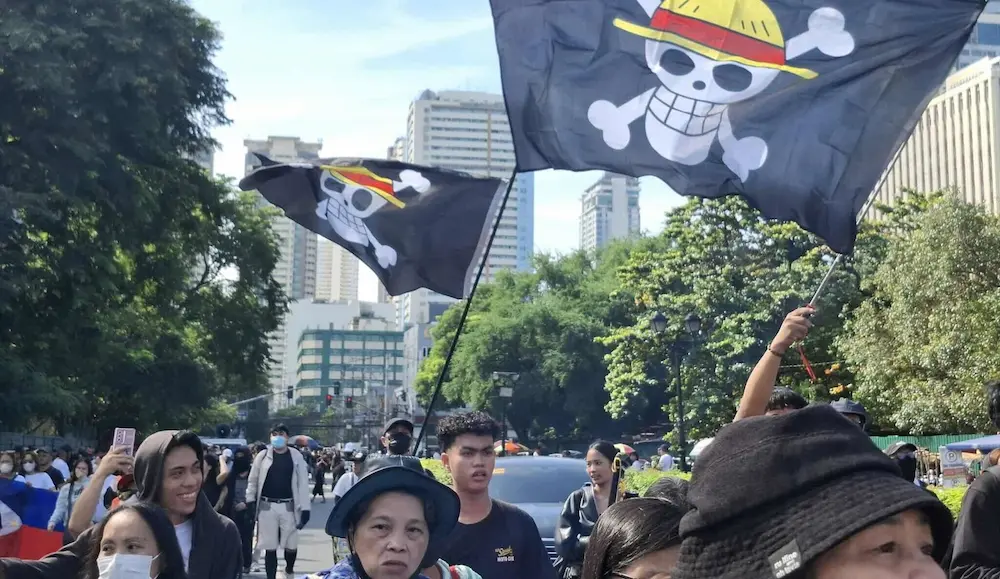
Why the Trillion Peso March Is a Defining Moment for Philippine Democracy and What the Flood Scam Revealed About Corruption and Civic Power in the Philippines
How a Flood Scam Sparked a People’s Storm – On September 21, 2025, the streets of Manila and other major cities in the Philippines were flooded not with water, but with people. Tens of thousands of Filipinos marched in protest against what is now being called the biggest corruption scandal in the country’s history: a multi-trillion peso fraud involving fake or substandard flood-control projects. The timing was symbolic, coinciding with the 53rd anniversary of Martial Law, and the mood was electric, angry, defiant, and determined.
This mass movement follows similar unrest in Nepal, where citizens recently rose up against government mismanagement and corruption. Now, the Philippines is witnessing its own wave of civic outrage, with protesters demanding justice, accountability, and reform.
Let’s break down this powerful moment in simple language and explore what led to it, who’s involved, and what it means for the future of the country.
What Sparked the Rage: The Flood Scam That Drowned Public Trust
The scandal began with a series of exposés revealing that billions of pesos allocated for flood-control projects had been misused. Some projects were never built. Others were so poorly constructed that they failed during recent monsoons, causing deadly floods across Luzon and Visayas.
Key facts:
- The Department of Finance estimates a loss of ₱118.5 billion ($2 billion) from 2023 to 2025 due to corruption in flood-control projects.
- Greenpeace claims the actual figure could be as high as $18 billion.
- Contractors Pacifico “Curlee” Discaya II and Cezarah “Sarah” Discaya allegedly bragged about owning 40 imported cars while linked to ghost projects.
The scandal came to light after President Ferdinand Marcos Jr. mentioned it in his July State of the Nation Address. Since then, public anger has grown rapidly, especially in flood-prone areas like Bulacan, where residents waded through water to join protests.
The Trillion Peso March: How Filipinos Took Over the Streets
On September 21, over 130,000 people gathered in Manila alone. The protests were held at iconic locations like Luneta Park and the EDSA People Power Monument, places tied to past movements for democracy and justice.
Highlights from the protests:
- The morning rally at Luneta drew nearly 50,000 people.
- The afternoon “Trillion Peso March” at EDSA was the main event, with chants of “Jail the corrupt!” echoing through the crowd.
- Protesters carried crocodile and pig cutouts to symbolize greedy politicians.
- Some wore white to show non-partisanship, others black to represent government decay.
The protests were mostly peaceful, but clashes broke out near Ayala Bridge and the presidential palace. Riot police used water cannons, and 72 people were arrested, including 20 minors.
Despite the violence, the message was clear: Filipinos are fed up with corruption and ready to act.
Who’s Involved: From Politicians to Priests, Students to Celebrities
The movement has united people from all walks of life, students, activists, religious leaders, and even celebrities.
Notable voices:
- Bishop Gerardo Alminaza quoted Psalms: “Because the poor are plundered, I will now arise”.
- Cardinal Pablo Virgilio David urged corrupt officials to repent and return stolen money.
- Former Bayan Muna Rep. Teddy Casiño said, “We will not stop until we get all of them”.
- Celebrities like Angel Aquino and Jodi Sta. Maria joined the rallies, shedding glamour for civic duty.
Universities along Taft Avenue formed the “One Taft Alliance,” condemning the scam and pledging support for future protests. Their statement read: “Let us drown the plunderers in the rage of our just demands.”
Even President Marcos Jr. acknowledged the protests, saying he didn’t blame people “one bit” for their anger.
What Happens Next: Justice, Reform, and the Power of People
The protests have already led to some political fallout:
- House Speaker Martin Romualdez resigned amid pressure.
- Three DPWH officials were dismissed for misconduct.
- Embassies issued safety alerts, warning of potential unrest.
But protesters say this is just the beginning. Civil society groups are vowing a “flood of cases” against those involved. The goal is not just punishment, but systemic change.
Demands include:
- Full investigation of all flood-control projects
- Jail time for corrupt lawmakers and contractors
- Transparency in infrastructure spending
- Stronger anti-corruption laws
The protests also serve as a reminder of the power of people. As one protester said, “The solution is not in the Senate or the House, it is with the Filipino people”.
A Storm of Accountability
The flood scam has exposed deep cracks in the Philippine government’s handling of public funds. But it has also awakened a powerful force the people. From the streets of Manila to the flooded alleys of Bulacan, Filipinos are demanding justice, and they’re not backing down.
This movement, inspired in part by Nepal’s recent unrest, shows that civic action can cross borders and ignite change. Whether the government listens or not, one thing is clear: the storm has arrived, and it’s not going away.
Also read: Nepal Youthquake: Army Steps In as Gen Z Protest Shakes the Nation
Stay informed with the latest news and updates – only on Rapido Updates.